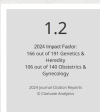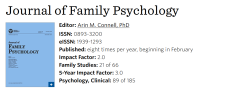Would you say that any papers from journals with a score below 5 should be at best taken with a grain of salt and preferably ignored? I sometimes consume academic literature and I hadn't heard of impact factors until you mentioned it.
Unfortunately, if we are relegated to only journals with impact factors over 5, we will need to disregard pretty much all existing research on human reproductive behavior (including most research on, e.g., eye contact, posture, peacocking, approach invitations, opening lines, flirtation, humor, sexual conversation, LMR, etc.).
Research into human mating runs into this impact factor problem that Wikipedia highlights:
Wikipedia said:
Impact factors are sometimes used to evaluate not only the journals but the papers therein, thereby devaluing papers in certain subjects.
I don't know why journals covering romantic and reproductive psychology are not cited nearly as highly as, say, journals on information management or oncology. (Well, I mean, actually I do: there is significantly less funding for these fields, thus significantly fewer papers being published, thus significantly fewer authors citing each individual paper, thus significantly fewer citations for journals in our space, thus significantly lower impact factors across the board.)
Basically you will only see journals >5 IF in the dating/relationships space if they also cover a lot of other stuff outside the space -- neuroscience, etc. Medical journals that occasionally publish papers in our space tend to have much higher IFs than pure psychology journals; pure psychology journals tend to have much higher IFs than journals niched down into reproductive psychology; etc.
There are only three journals I can see with impact factors >5 that somewhat regularly deal with sexual and romantic behavior (Evolution and Human Behavior: ~5.1 in 2023; Psychological Science: ~9.2 in 2023; Personality and Social Psychology Review: ~10.2 in 2023). The only one of these that publishes frequently in this space is Evolution and Human Behavior (and even that one, a bunch of sources have its impact factor under 5 now). That journal (Evolution and Human Behavior) does
happen to have a study supporting a promiscuity-infidelity link. I highlight the relevant quote in this article (infidelity risk factor #5/49):
A cheater doesn’t cheat out of nowhere. She leaves clues, hints, and signs – some of them quite obvious. These 49 signs tell you she may soon cheat on you. Contents 1. Introduction 2. Sex-Related Risk Factors 3. Lifestyle Risk Factors 4. Visible Risk Factors 5. Behavioral Risk Factors 6...

www.girlschase.com
But that being said -- I am a bit surprised to see this thread still going.
Looks like it is going in circles.
From what I can see here the debate has somewhat devolved into this:
LOW COUNT GUYS: "If she's high count, she's too risky, thus automatically ruled out."
HIGH COUNT GUYS: "It's silly to weigh count at all, because count is not the only factor."
There's some kind of polarization effect occurring in this thread, where both sides have pushed each other into extreme positions.
It's like a political debate!
"Tune in at 11 as two senatorial candidates argue the merits of low vs. high body counts among female aides and assistants!"
Chase






